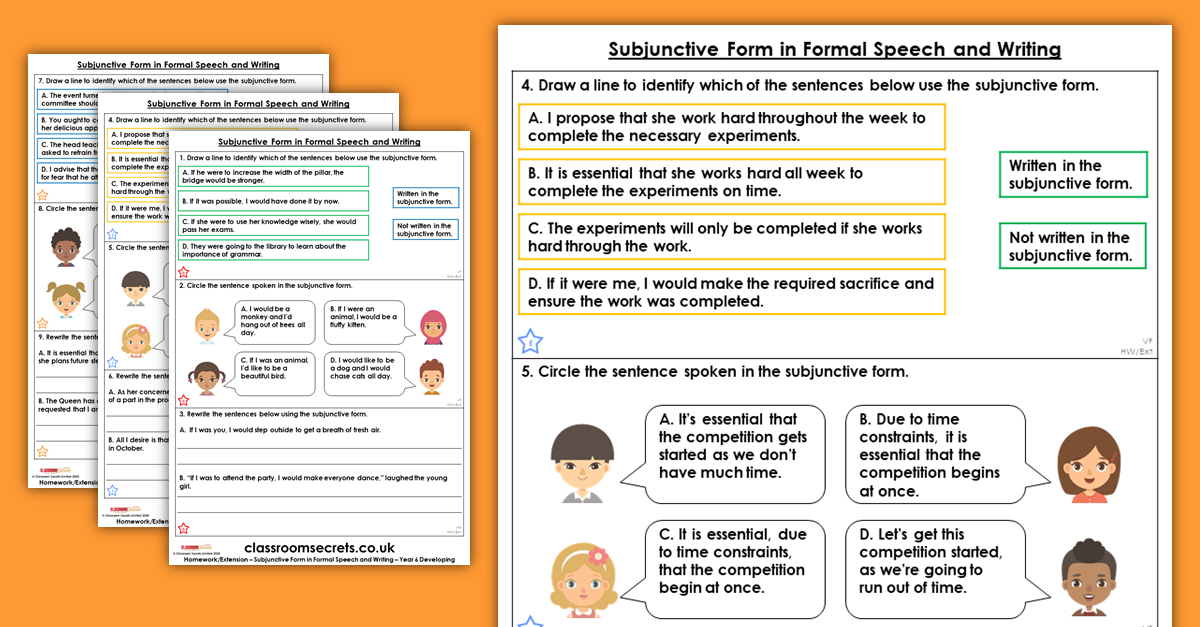Year 6 Subjunctive Form in Formal Speech and Writing Homework Extension Formal and Informal

Step 2: Year 6 Subjunctive Form in Formal Speech and Writing Homework Extension Spring Block 3
Year 6 Subjunctive Form in Formal Speech and Writing Homework Extension provides additional questions which can be used as homework or an in-class extension for the Year 6 Subjunctive Form in Formal Speech and Writing Resource Pack. These are differentiated for Developing, Expected and Greater Depth.
More resources for Spring Block 3 Step 2.
Not a member? Sign up here.
What's included in the pack?
This pack includes:
- Year 6 Subjunctive Form in Formal Speech and Writing Homework Extension with answers for Year 6 Spring Block 3.
National Curriculum Objectives
English Year 6: (6G7.4) Recognising vocabulary and structures that are appropriate for formal speech and writing, including subjunctive forms
English Year 6: (6G7.2) The difference between vocabulary typical of informal speech and vocabulary appropriate for formal speech and writing [for example, find out – discover; ask for – request; go in – enter]
Differentiation:
Questions 1, 4 and 7 (Varied Fluency)
Developing Identify which sentences use the subjunctive form of ‘to be’ to express statements contrary to fact or to express wishes. Predominantly Y3/Y4 spelling list words.
Expected Identify which sentences use the subjunctive form of 'to be’ and a variety of verbs that follow expressions of desire, demands or formal recommendations. Predominantly Y5/Y6 spelling list words.
Greater Depth Identify which sentences use the subjunctive form of 'to be’ and a variety of verbs that follow expressions of desire, demands or formal recommendations. Archaic language used.
Questions 2, 5 and 8 (Varied Fluency)
Developing Circle the sentence which uses the subjunctive form of ‘to be’ to express statements contrary to fact or to express wishes. Predominantly Y3/Y4 spelling list words.
Expected Circle the sentence which uses the subjunctive form of 'to be’ and a variety of verbs that follow expressions of desire, demands or formal recommendations. Predominantly Y5/Y6 spelling list words.
Greater Depth Circle the sentences which use the subjunctive form of 'to be’ and a variety of verbs that follow expressions of desire, demands or formal recommendations. Archaic language used.
Questions 3, 6 and 9 (Application and Reasoning)
Developing Rewrite sentences in the subjunctive form. Includes the subjunctive form of ‘to be’ to express statements contrary to fact or to express wishes. Predominantly Y3/Y4 spelling list words.
Expected Rewrite sentences in the subjunctive form. Includes the subjunctive form of 'to be’ and a variety of verbs that follow expressions of desire, demands or formal recommendations. Predominantly Y5/Y6 spelling list words.
Greater Depth Rewrite sentences in the subjunctive form. Includes the subjunctive form of 'to be’ and a variety of verbs that follow expressions of desire, demands or formal recommendations. Archaic language used.
This resource is available to download with a Premium subscription.






